|
DIY:
Shortening of a Neil Pryde X9 boom.
The cause for taking up
this topic is that Neil Pryde is currently emptying the stock of outdated
long X9 booms (260 - 310 cm) - booms that are way too long to be sold in
this new era of cut-out clews. The prize in my country (Denmark) is lowered to around
533 Euros, which is well under half the normal price.
In this example the
shortening of the boom is 40 cm, and that's about the most you can cut off a
X9 boom if you want to retain the possibility to adjust the boom with 50
cm.
|
|
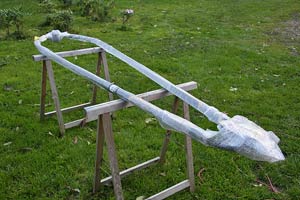
1.
A
brand new Neil Pryde 310-260 cm boom is ready on the
operation table.
Click the
picture to enlarge. |
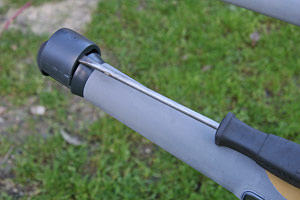
2.
The pin part of the trim lock mechanism is removed.
Click the picture to
enlarge. |

3.
Pretty often the glued-on part of the trim
lock mechanism can be knocked off right away. If this isn't the case,
dipping it in hot water will probably loosen it ...
Click the picture to
enlarge. |
|
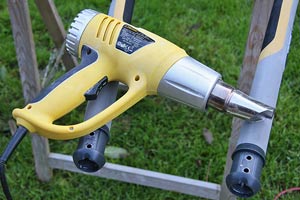
4.
... or you can loosen it
by means of a heat device (don't over-heat!).
Click the
picture to enlarge. |
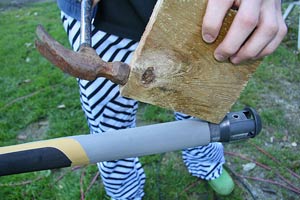
5.
The glued-on part of the
trim lock mechanism is knocked off (gently, if you want to be sure not to
destroy it).
Click the
picture to enlarge. |
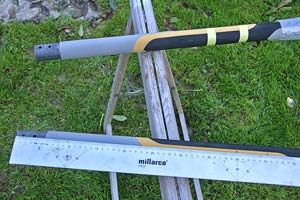
6.
Mark where you want to
cut the tubes, and also mark where to remove the grip. In this case the
boom is intended to be 40 cm shorter than the original length - making it
a 270-220 cm boom.
40 cm is about the most
you can cut off, if you want to retain the 50 cm trim option. Of course
you can cut off (say) 60 cm, but to make (a little!) sense you'll then have to cut off
20 cm from the boom end, making the new boom a 250-220 cm boom (and
thereby easing the boom a few grams).
Click the
picture to enlarge. |
|
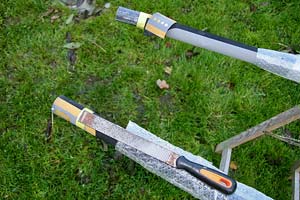
7.
The tubes have been
shortened 40 cm, and now you'll have to remove some grip material, so
that the trim lock parts can fit over the boom tubes. Sometimes the grip is
glued on so poorly that you can remove it with your bare hands - otherwise
you'll have to use a knife or a file.
Click the
picture to enlarge. |
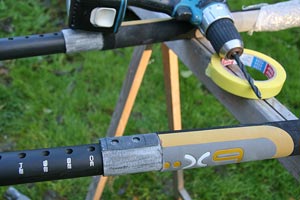
8.
Now you'll have to drill
some holes, so that the pin parts of the trim lock pieces can hit the
holes in the boom end. A little precision is needed here, so why not make
a shape (pattern) from one of the cut off tube pieces?
Click the
picture to enlarge. |
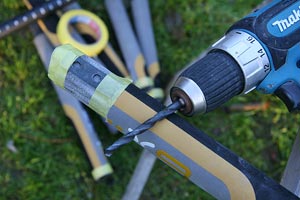
9.
The shape is fixed with
tape and ready for drilling.
Click the
picture to enlarge. |
|
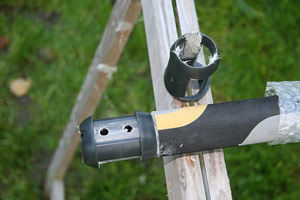
10.
The holes are drilled,
and one of the trim lock pieces is glued on. You can use almost every
thing for this glue job (epoxy resin (best), contact cement, fibre filled
polyester putty (used here), or ...).
Click the
picture to enlarge. |
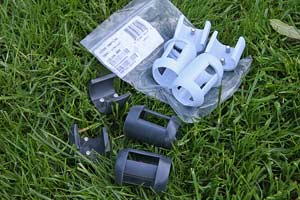
11.
Just to show that if
you're unlucky to destroy some of the trim lock pieces, you can buy some
replacement parts from Neil Pryde/your local windsurf pusher).
Click the
picture to enlarge. |
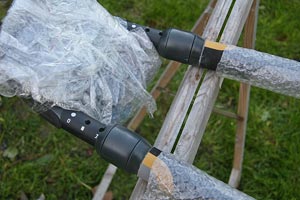
12.
The boom is shortened and
ready for use.
Click the
picture to enlarge. |
|
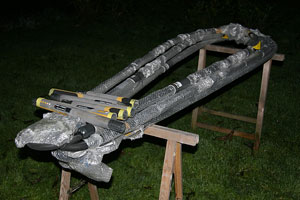
13.
As you've seen this is a minor operation.
Here 3 booms have been modified within a couple of hours.
The cut off tube pieces
can easily be modified to downhaul devices - but that's another story ...
Click the
picture to enlarge. |
|
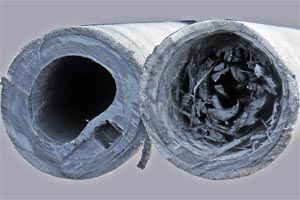
14.
Booms from other brands.
I've
done similar shortenings of booms from other companies (Gaastra, Maui
Sails etc.), and mostly it's easily done. Keeping an eye on the curving
and diameter of the tubes usually indicates how much shortening the boom
accepts.
However, sometimes you get surprised. For instance when trying to shorten
a Nautix Carbon boom (at least the older ones) you risk that the tubes are
irregular shaped
i
or filled with very long and strong "corks" from carbon weave. There's no
way you can get away with shortening this kind of boom, as it's impossible
to make room for the extension.
Click the
picture to enlarge. |